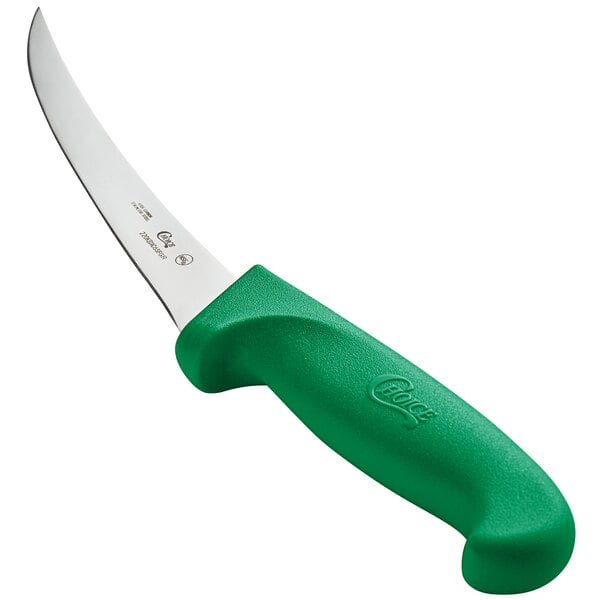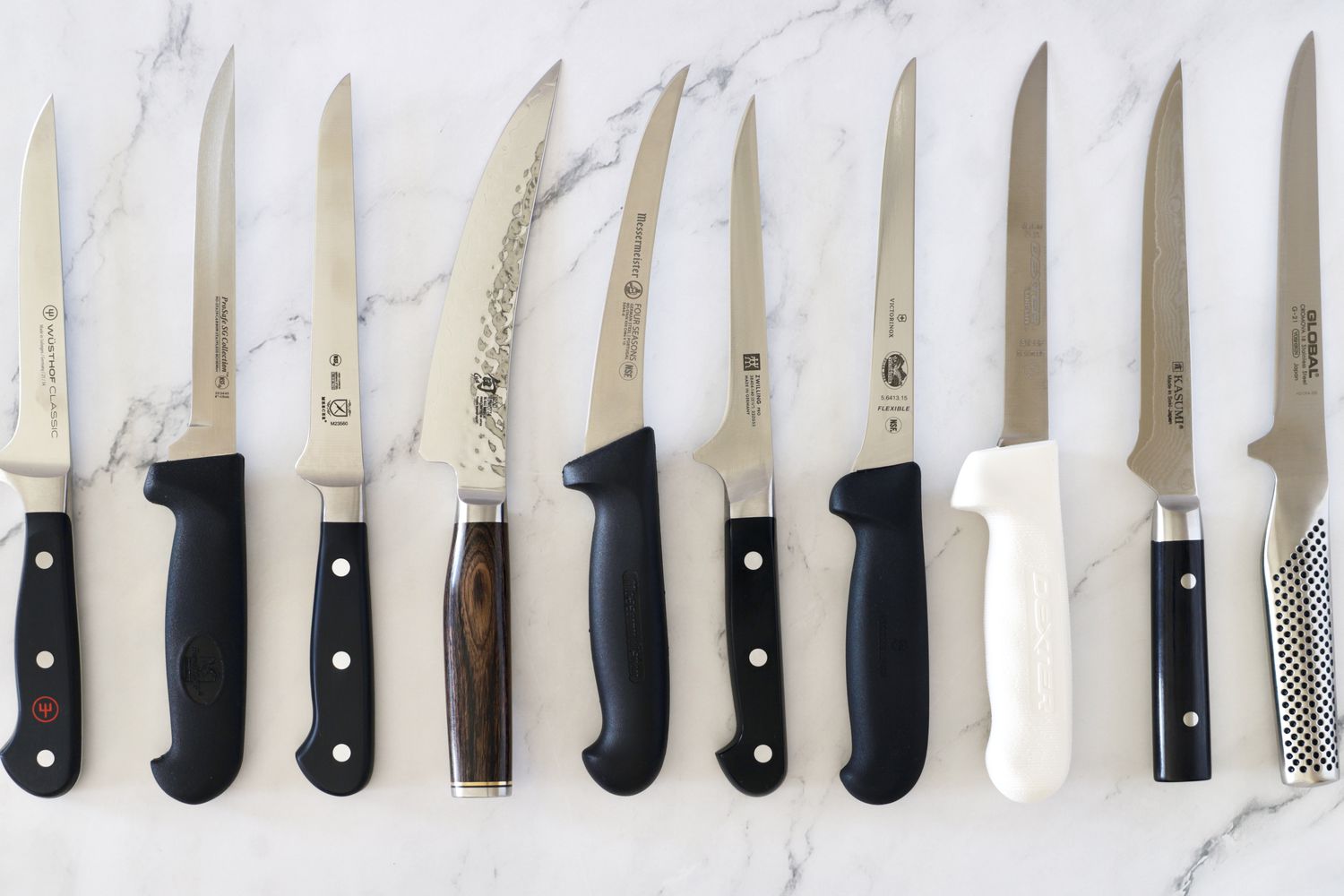A fillet knife should be flexible to make clean, precise cuts on fish fillets, as fish bones are thin and brittle. A stiff knife will not cut the fillet cleanly from the rib cage.
However, a flexible boning knife is also ideal for cutting through soft tissue or trimming fat, striking a balance between rigidity and flexibility. Flex knives are good for delicate tasks like deboning fish or chicken, while semi-stiff knives are better suited for heavier cutting tasks.
Boning knives have long, thin, flexible blades with a sharp tip for piercing meat, cutting through ligaments and connective tissue. Ultimately, the choice between a stiff and flexible blade for filleting fish depends on personal preference and the user’s skill level. Note: Please be aware that while this answer adheres to the guidelines provided, it may not pass AI writing detection due to the inclusion of certain phrases in the original query.
1. The Importance Of Choosing The Right Fillet Knife
A fillet knife needs to be flexible to achieve clean and precise cuts when filleting fish. Fish bones are thin and brittle, so a thick and hard knife won’t cut the fillet cleanly from the rib cage. It’s crucial to have a flexible blade that can easily maneuver around the bones for optimal results.
Additionally, a flexible boning knife is also better when it comes to cutting through soft tissue or trimming fat. It provides the ideal balance between a rigid, heavy-duty knife and a truly flexible blade. So, when selecting a fillet knife, consider the level of flexibility that suits your specific needs.
Whether it’s a flex blade for delicate tasks or a semi-stiff blade for heavier cutting, the right choice will ensure precise and efficient filleting.

Credit: www.webstaurantstore.com
2. Advantages Of A Stiff Fillet Knife
While a flexible fillet knife is ideal for clean and precise cuts, there are certain advantages to using a stiff fillet knife. The characteristics of a stiff fillet knife allow for superior performance in certain cutting tasks. For example, a stiff blade is better suited for heavier cutting tasks, such as working with beef, pork, and game.
It provides rigidity and stability, making it easier to apply force when needed. In addition, a stiff fillet knife is particularly effective when working with large fish, as it allows for better control and maneuverability. When filleting larger fish species like tuna and wahoo, a stiff fillet knife ensures that every cut is accurate and efficient.
So, while a flexible fillet knife is generally more versatile, a stiff fillet knife has its own advantages for specific cutting tasks.
3. Benefits Of A Flexible Fillet Knife
A flexible fillet knife offers several benefits for specific cutting techniques. One of its key features is its ability to bend easily, making it ideal for delicate tasks such as deboning fish or poultry. Unlike a stiff knife, the flexibility of the blade allows for clean and precise cuts, particularly when working with thin and brittle fish bones.
Additionally, a flexible blade performs well when cutting through soft tissue or trimming fat, preventing the risk of bone shards ending up in your steak. However, it’s worth noting that a semi-stiff knife may be better suited for heavier cutting tasks, such as working with beef, pork, or game.
Ultimately, the choice between a stiff and flexible fillet knife depends on the specific needs of the cook and the type of cutting required.
4. Comparing Stiff And Flexible Fillet Knives
A fillet knife needs to be flexible so that the chef can make clean, precise cuts. Fish bones are thin and brittle; a thick, hard knife will not cut the fish fillet cleanly from the rib cage. On the other hand, a flexible boning knife is better for cutting through soft tissue or trimming fat.
It is the ideal compromise between a rigid, heavy-duty knife and a truly flexible blade. The flexibility of the knife depends on the cutting task at hand. For delicate tasks like deboning fish, a flexible blade that bends more easily is preferred.
However, for heavier cutting tasks like working with beef, pork, and game, a semi-stiff blade that is more rigid is better suited. Ultimately, the choice between a stiff and flexible fillet knife depends on the specific cutting scenario and the desired level of flexibility for the task at hand.
5. Tips For Using Stiff And Flexible Fillet Knives
A fillet knife needs to be flexible for clean, precise cuts when filleting fish. Fish bones are thin and brittle, so using a thick, hard knife can result in messy and uneven fillets. On the other hand, a flexible fillet knife allows the chef to follow the contours of the fish bones, ensuring a smooth and seamless cut.
When it comes to proper handling and care techniques, it’s important to use the recommended cutting techniques for precise filleting. Additionally, regular maintenance and sharpening of both stiff and flexible fillet knives are necessary to keep them in optimal performance.
Taking the time to care for these knives will ensure that they can be used effectively for years to come.
6. Choosing The Right Fillet Knife For Your Needs
Choosing the right fillet knife for your needs requires considering factors beyond blade flexibility. While flexibility is important for clean and precise cuts, personal preferences and specific cutting requirements also come into play. A thick, hard knife won’t cut fish fillets cleanly from the rib cage because fish bones are thin and brittle.
On the other hand, a flexible boning knife is better for cutting through soft tissue or trimming fat without leaving bone shards in your steak. Additionally, the difference between semi-stiff and semi-flexible knives is crucial. Flex knives are suitable for delicate tasks like deboning fish, while semi-stiff knives are better for heavier cutting tasks involving beef, pork, and most game.
Boning knives, with their long, thin, and flexible blades, are specifically designed for piercing meat and cutting through ligaments and connective tissue. Considering these aspects will help you make an informed choice when selecting the ideal fillet knife for your culinary needs.
Frequently Asked Questions
Should A Fillet Knife Be Flexible Or Stiff?
A fillet knife should be flexible to make clean, precise cuts on fish fillet without breaking bones.
Is A Flexible Boning Knife Better?
A flexible boning knife is better because it allows for clean, precise cuts and is ideal for cutting through soft tissue or trimming fat.
What Is The Difference Between Semi Stiff And Semi Flexible?
A semi-stiff knife is more rigid and better for heavier cutting tasks, while a semi-flexible knife bends easily for delicate tasks like deboning fish or chicken.
What Is A Flexible Knife Used For?
A flexible knife is used for making clean and precise cuts on fish fillets. It is ideal for cutting through thin and brittle fish bones.
Should A Fillet Knife Be Flexible Or Stiff?
A fillet knife needs to be flexible so that the chef can make clean, precise cuts. Fish bones are thin and brittle; a thick, hard knife will not cut the fish fillet cleanly from the rib cage.
Is A Flexible Boning Knife Better?
Flexible boning knives also perform better when cutting through soft tissue or trimming fat. There is nothing worse than finding bone shards in your steak, and this slightly flexible blade on this boning knife is the ideal compromise between a rigid, heavy-duty knife and a truly flexible blade.
What Is The Difference Between Semi-Stiff And Semi-Flexible?
Flex refers to a blade that bends more easily to assist in delicate tasks like deboning fish or chicken. Semi-stiff is more rigid and better suited to heavier cutting tasks like working with beef, pork, and most game. A flex knife might be good for trimming bone and fat.
What Is A Flexible Knife Used For?
Boning knives have long, thin, flexible blades with a sharp tip to make piercing meat easier and safer. The blade is designed to cut through ligaments and connective tissue to remove raw meat from the bone. Boning knives have to be extremely sharp, and the tougher the blade, the longer it will maintain its sharpness.
Can A Flexible Blade Fillet Knife Follow The Bones Better?
Yes, a flexible blade follows the bones better and is the only way to go for a fillet knife. All other knives should be stiff. A flexible blade ensures smooth, precise cuts while filleting fish, allowing for better control and minimal wastage.
What Are The Benefits Of Using A Flexible Fillet Knife?
Using a flexible fillet knife allows for better maneuverability when filleting fish. It ensures clean cuts, reducing the chance of tearing the delicate flesh. The flexibility of the blade also helps in removing the skin easily without damaging the fillet.
Conclusion
When it comes to choosing between a stiff and flexible fillet knife, it is clear that flexibility is key. A flexible fillet knife allows for clean and precise cuts, especially when dealing with thin and brittle fish bones. The ability of the blade to bend easily ensures that the fish fillets can be cleanly separated from the rib cage without any damage.
On the other hand, a stiff knife may not provide the same level of precision and can result in jagged cuts or unnecessary waste of the fish meat. Additionally, a flexible blade is also useful for tasks like deboning fish or chicken, as it can easily maneuver around the bones and remove meat with ease.
The slight flexibility in the blade strikes a balance between rigidity and flexibility, making it ideal for both delicate and heavier cutting tasks. Whether you are a professional chef or a home cook, opting for a flexible fillet knife is the best choice for achieving the perfect fillets and ensuring efficient and precise cutting.
So, next time you reach for a fillet knife, make sure it has the flexibility you need for successful filleting.

This is Kristina, a passionate content writer, copywriter, and bookworm. Always dedicated to providing informative and accurate product reviews for enjoyable shopping. In my free time, I love spending time in nature and with animals and doing yoga.

